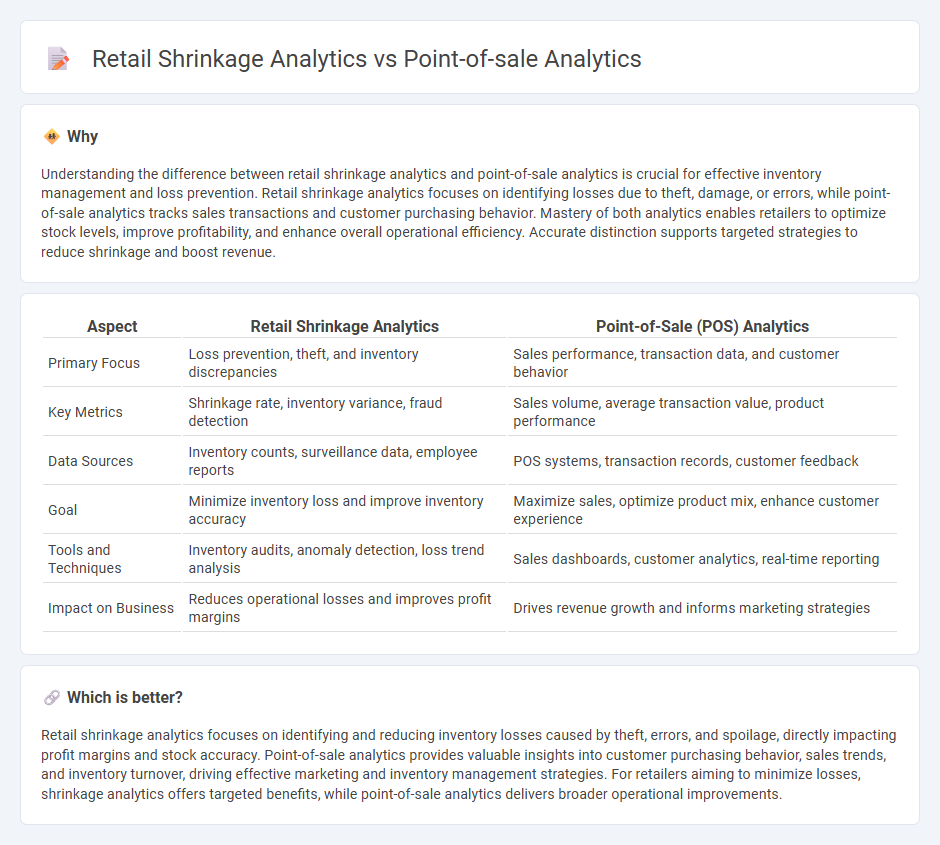
Retail shrinkage analytics focuses on identifying and reducing losses caused by theft, errors, and fraud, using data from inventory discrepancies and loss prevention systems. Point-of-sale analytics examines sales transactions to optimize pricing, promotions, and customer behavior insights for improved revenue and operational efficiency. Explore how integrating these analytics can enhance overall retail performance and profitability.
Why it is important
Understanding the difference between retail shrinkage analytics and point-of-sale analytics is crucial for effective inventory management and loss prevention. Retail shrinkage analytics focuses on identifying losses due to theft, damage, or errors, while point-of-sale analytics tracks sales transactions and customer purchasing behavior. Mastery of both analytics enables retailers to optimize stock levels, improve profitability, and enhance overall operational efficiency. Accurate distinction supports targeted strategies to reduce shrinkage and boost revenue.
Comparison Table
| Aspect | Retail Shrinkage Analytics | Point-of-Sale (POS) Analytics |
|---|---|---|
| Primary Focus | Loss prevention, theft, and inventory discrepancies | Sales performance, transaction data, and customer behavior |
| Key Metrics | Shrinkage rate, inventory variance, fraud detection | Sales volume, average transaction value, product performance |
| Data Sources | Inventory counts, surveillance data, employee reports | POS systems, transaction records, customer feedback |
| Goal | Minimize inventory loss and improve inventory accuracy | Maximize sales, optimize product mix, enhance customer experience |
| Tools and Techniques | Inventory audits, anomaly detection, loss trend analysis | Sales dashboards, customer analytics, real-time reporting |
| Impact on Business | Reduces operational losses and improves profit margins | Drives revenue growth and informs marketing strategies |
Which is better?
Retail shrinkage analytics focuses on identifying and reducing inventory losses caused by theft, errors, and spoilage, directly impacting profit margins and stock accuracy. Point-of-sale analytics provides valuable insights into customer purchasing behavior, sales trends, and inventory turnover, driving effective marketing and inventory management strategies. For retailers aiming to minimize losses, shrinkage analytics offers targeted benefits, while point-of-sale analytics delivers broader operational improvements.
Connection
Retail shrinkage analytics and point-of-sale analytics are interconnected through the use of transactional data to identify patterns of inventory loss and theft. By analyzing point-of-sale data, retailers can detect discrepancies between sales records and actual stock levels, enabling targeted investigations into shrinkage causes. This integration enhances loss prevention strategies by providing real-time insights into both employee behavior and customer transactions.
Key Terms
**Point-of-sale analytics:**
Point-of-sale analytics captures real-time transaction data to optimize sales performance, inventory management, and customer behavior insights in retail environments. It leverages tools like POS software, data visualization, and machine learning to identify sales trends, peak buying times, and product preferences. Explore how point-of-sale analytics can drive smarter retail decisions and increase profitability.
Transaction data
Point-of-sale analytics primarily examines transaction data to optimize sales processes, improve inventory management, and enhance customer experience by analyzing purchase patterns and payment methods. Retail shrinkage analytics uses transaction data to identify discrepancies caused by theft, fraud, or administrative errors, focusing on loss prevention and minimizing financial impact. Explore more to understand how leveraging transaction data can transform retail operations and loss management.
Basket analysis
Point-of-sale analytics centers on basket analysis by examining transactional data to identify purchase patterns, product affinities, and cross-selling opportunities that drive revenue growth. Retail shrinkage analytics, in contrast, leverages basket analysis to detect anomalies and theft by scrutinizing discrepancies between expected and actual sales data at the SKU level. Explore the nuances of how integrating basket analysis in both analytics types enhances operational efficiency and loss prevention strategies.
Source and External Links
Point-of-Sale Data Analysis AI Agents - Relevance AI - Point-of-sale analytics examines transaction data to provide detailed insights such as customer behavior, inventory status, sales trends, and predictive forecasting, helping retailers transform raw data into actionable intelligence for smarter business decisions.
Maximizing Business Growth with POS Data Analysis - POS analytics involves analyzing detailed sales, customer, and inventory data captured at transaction points to identify peak sales times, product performance, customer buying habits, and inventory needs, enabling better marketing, pricing, and stock management.
Understanding POS Data: Unlocking Insights for Your Business - POS data analytics combines various transactional data sets to define KPIs, identify trends, and create actionable strategies while addressing challenges like large data volume and data integration to improve retail operations and decision-making.
 dowidth.com
dowidth.com